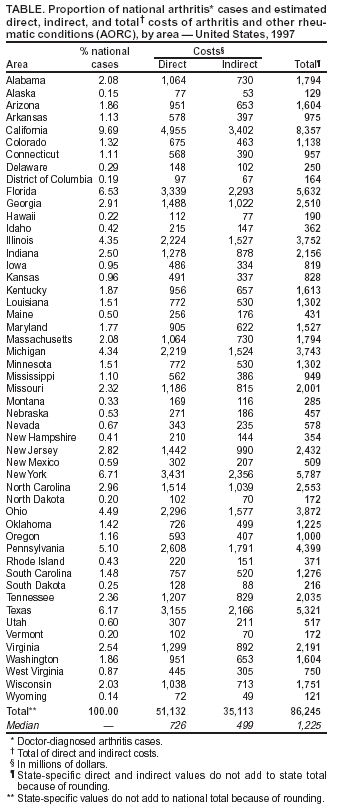 |
|
|
|
|
|
|
|
|
|
|
|
|
|
|
|
|
||||
| ||||||||||
|
|
|
|
Update: Direct and Indirect Costs of Arthritis and Other Rheumatic Conditions --- United States, 1997The medical and societal impact of arthritis and other rheumatic conditions (AORC) has been characterized with respect to disability (1), ambulatory care (2), hospitalization (3), and economic burden (4,5). CDC's estimates of the national and state-specific costs of AORC in the United States in 1997 have been published previously (4). However, CDC has re-estimated indirect costs by enhancing the statistical methods. This report summarizes the results of that analysis, which indicated that indirect costs were $30.1 billion less than previously estimated. The total cost of AORC in the United States in 1997 was $86.2 billion (including $51.1 billion in direct costs and $35.1 billion in indirect costs), approximately 1% of the U.S. gross domestic product. Total costs attributable to AORC by state ranged from $121 million in Wyoming to $8.4 billion in California. Although indirect costs were lower than estimated previously, costs for arthritis remain high and underscore the need for better interventions to reduce the economic burden of arthritis. Data from the 1997 Medical Expenditure Panel Survey and 2002 Behavioral Risk Factor Surveillance System were used to derive estimated costs; these data also were used in the previous report (4). In this analysis, direct costs were medical-care expenditures, and indirect costs were lost earnings attributable to AORC. A total of 22,435 respondents aged >18 years had complete data for all covariates. As with the previous study, a series of two- and four-stage Duan econometric regression models (6) were used to derive individual-level direct and indirect cost estimates. Direct cost models adjusted for six sociodemographic factors (i.e., categorized age [18--44 years (referent group), 45--64 years, and >65 years], sex, race, Hispanic ethnicity, marital status, and education level), health insurance status, and nine of the most costly comorbidities (i.e., hypertension, other forms of heart disease, pulmonary conditions, stroke, other neurologic conditions, diabetes, cancer, mental illness, and nonarthritis musculoskeletal conditions). Indirect costs also were estimated by using the Duan two- and four-stage models with adjustments for the same sociodemographic and comorbidity variables as used for the direct cost estimates. However, the indirect models did not include health insurance. Two modifications were made to the original indirect models. First, age was included in the updated model as a categorical rather than a continuous variable (using the age groups 18--34 years [referent group], 35--44 years, 45--54 years, and 55--64 years). Age was modeled in categorical form to reflect a nonlinear relation between age and indirect costs. Second, nine costly comorbidities were included in the indirect model; these variables were omitted in the previous analysis. Results from the enhanced analysis reflect a model that adjusts for sociodemographic variables and nine costly comorbidities. Methods for generating the increment and total costs attributable to AORC were the same as described previously (4). No changes were made to the cost estimates or attributable fractions for direct costs. The national indirect cost estimates decreased by $30.1 billion. The revised total cost of AORC in the United States was $86.2 billion (i.e., $51.1 billion in direct costs plus $35.1 billion in indirect costs). By state, indirect costs for AORC ranged from $49 million in Wyoming to $3.4 billion in California (median: $499 million), and total costs ranged from $121 million in Wyoming to $8.4 billion in California (Table). Reported by: L Murphy, Business Computer Applications, Inc., Duluth, Georgia. M Cisternas, MA, MGC Data Svcs, Carlsbad; E Yelin, PhD, L Trupin, MPH, Univ of California, San Francisco. CG Helmick, MD, Div of Adult and Community Health, National Center for Chronic Disease Prevention and Health Promotion, CDC. Editorial Note:This report presents enhanced population-based indirect and total cost estimates of AORC for states and the nation in 1997, based on a revised statistical model. Direct cost estimates are unchanged from those in the previous report for AORC, but the revised indirect cost estimates are now less than the direct costs, which is the opposite of what was found in the original analysis (4). Because the indirect costs only included value of time lost from work among persons aged 18--64 years, these estimates might be considered conservative. The strengths and limitations discussed in the previous report also apply to these estimates (4). The statistical enhancement proved important in reducing residual confounding in the model on which the indirect cost estimates were based, and illustrates how simple choices, such as the variable form (e.g., continuous versus categorical), can result in substantially different cost estimates. In this study, inclusion of a categorized, rather than continuous, age variable resulted in a 17% decrease in the national estimate of total AORC costs. Review of the current cost-of-illness (COI) literature indicates that many COI studies are limited to estimating direct costs, although indirect costs are an important measure of societal burden of disease. In addition, few methodologic standards are available for the statistical estimation of indirect costs. Developing a consensus on methodologic standards for COI studies will help ensure that study results are valid and comparable across disease groupings and therefore of greatest value to policy makers. References
Table  Return to top.
Disclaimer All MMWR HTML versions of articles are electronic conversions from ASCII text into HTML. This conversion may have resulted in character translation or format errors in the HTML version. Users should not rely on this HTML document, but are referred to the electronic PDF version and/or the original MMWR paper copy for the official text, figures, and tables. An original paper copy of this issue can be obtained from the Superintendent of Documents, U.S. Government Printing Office (GPO), Washington, DC 20402-9371; telephone: (202) 512-1800. Contact GPO for current prices. **Questions or messages regarding errors in formatting should be addressed to mmwrq@cdc.gov.Page converted: 5/12/2004 |
|||||||||
This page last reviewed 5/12/2004
|